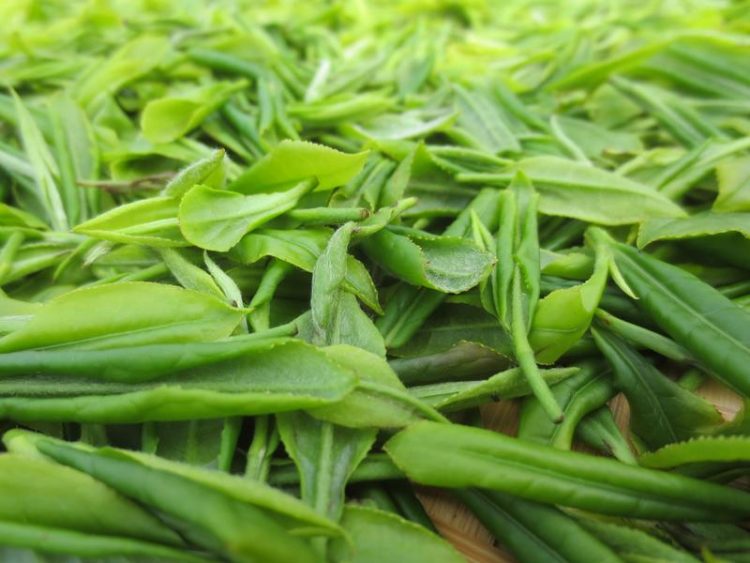Genetic key to "healthy" tea

Freshly picked tea. The Chinese-German research team analysed more than 200 different varieties and identified their gene variants. Weiwei Wen / Huazhong Agricultural University
Tea (Camellia sinensis) is one of the world's most popular drinks with a wide range of flavours and health benefits. Researchers from Huazhong Agricultural University of Wuhan (China), Forschungszentrum Jülich, Heinrich Heine University Düsseldorf and the Max Planck Institute of Molecular Plant Physiology Potsdam-Golm have now elucidated the genome of an ancient tea tree and analysed more than 200 different tea varieties.
The genome now forms the basis for further research into the biosynthesis of useful natural substances. The study was led by the plant researcher Prof. Weiwei Wen from Wuhan.
On the German side, the Jülich genome researcher Prof. Björn Usadel collaborated with the expert for plant metabolic processes Prof. Alisdair Fernie from Potsdam-Golm as part of the international Bioeconomy Initiative of the BMBF.
In 2018, around 273 billion litres of tea were consumed worldwide. The trend is rising and makes tea one of the most popular soft drinks. However, tea is not only used for refreshment, tea has already been used in traditional Chinese medicine.
The research team was concerned with the question of which natural ingredients are responsible for the taste and health-promoting properties.
To this end, they used the genetic characterization of old and wild tea varieties to trace the development of modern tea varieties. By analysing more than 200 different tea varieties from different growing regions, the scientists were able to identify gene variants that are responsible for the biosynthesis of healthy secondary plant compounds, the flavonoids. These include in particular catechins, bitter compounds in plants with high antioxidant potential.
These results could form the basis for improved breeding of healthy tea varieties. The scientists were able to show for the first time that, in contrast to other crops, targeted breeding with regard to secondary plant substances is rarely carried out.
With the high-resolution genome data of old and wild tea varieties, new varieties can now be bred in the future to satisfy the growing international demand for “healthy” tea.
Prof. Alisdair Fernie
Max-Planck-Institut für Molekulare Pflanzenphysiologie
Telefon: 0331 567 8211
E-Mail: fernie@mpimp-golm.mpg.de
Prof. Dr. Björn Usadel
Institut für Bio- und Geowissenschaften, Bereich Bioinformatik (IGB-4)
Forschungszentrum Jülich und
Institute for Biological Data Science
Heinrich-Heine Universität Düsseldorf
Tel. 02461 61 85801
E-Mail: b.usadel@fz-juelich.de
Dr. Diana Klose
Institut für Bio- und Geowissenschaften, Bereich Bioinformatik (IBG-4)
Forschungszentrum Jülich
Tel. 02461 61 85852
E-Mail: d.klose@fz-juelich.de
Tel. 02461 61 85801
Weiji Zhang, Youjun Zhang, Haiji Qiu, Yafei Guo, Haoliang Wan, Xiaoliang Zhang, Federico Scossa, Saleh Alseekh, Qinguhua Zhang, Pu Wang, Li Xu, Maximilian H.-W. Schmidt, Xinxin Jia, Daili Li, Anting Zhu, Fei Guo, Wei Chen, Dejiang Ni, Björn Usadel, Alisdair R. Fernie and Weiwei Wen
Genome assembly of wild tea tree DASZ reveals pedigree and selection history of tea varieties
Nature communications, 24 July 2020, https://doi.org/10.1038/s41467-020-17498-6
https://www.mpimp-golm.mpg.de/4186/dep_1
https://www.mpimp-golm.mpg.de/5858/4fernie
http://usadellab.org/cms/
https://www.fz-juelich.de/portal/EN/institutes/InstituteBioGeosciences/ibg-4-en….
Media Contact
All latest news from the category: Life Sciences and Chemistry
Articles and reports from the Life Sciences and chemistry area deal with applied and basic research into modern biology, chemistry and human medicine.
Valuable information can be found on a range of life sciences fields including bacteriology, biochemistry, bionics, bioinformatics, biophysics, biotechnology, genetics, geobotany, human biology, marine biology, microbiology, molecular biology, cellular biology, zoology, bioinorganic chemistry, microchemistry and environmental chemistry.
Newest articles

First-of-its-kind study uses remote sensing to monitor plastic debris in rivers and lakes
Remote sensing creates a cost-effective solution to monitoring plastic pollution. A first-of-its-kind study from researchers at the University of Minnesota Twin Cities shows how remote sensing can help monitor and…

Laser-based artificial neuron mimics nerve cell functions at lightning speed
With a processing speed a billion times faster than nature, chip-based laser neuron could help advance AI tasks such as pattern recognition and sequence prediction. Researchers have developed a laser-based…

Optimising the processing of plastic waste
Just one look in the yellow bin reveals a colourful jumble of different types of plastic. However, the purer and more uniform plastic waste is, the easier it is to…



